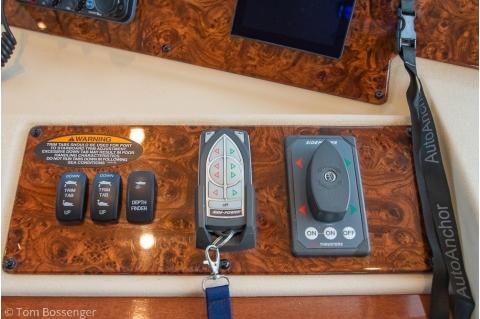POD Drives vs Dock-On-Command (DOC

Meridian's "Dock on Command" vs. Pod Drives
Pod drives have transformed the docking experience, allowing even novice boaters to navigate tight spots with ease. Thanks to their advanced joystick controls and precise maneuverability, pod drives have made docking a breeze, offering the kind of control that feels intuitive and effortless. However, these advantages come with a trade-off: high maintenance costs. Pod drives, while innovative, are complex systems that require ongoing upkeep, and their underwater components can be costly to service or replace.
Before pod drives came onto the scene, Meridian’s "Dock on Command" (DOC) system led the way in simplifying docking. While it may not have the same level of sophistication as pod drives, this earlier technology offers a straightforward, reliable alternative with a key advantage: reduced maintenance costs.
Why "Dock on Command" Still Holds Its Own
Meridian’s "Dock on Command" system, like the system on our 2008 Meridian 580 “Janabanana,” combines bow and stern thrusters with joystick controls, giving boaters the ability to move laterally and spin on a central axis. This intuitive setup was ahead of its time, making docking simpler long before pod drives arrived on the market. Let's explore why DOC still holds its own in today’s world of high-tech docking solutions.
1. Simple, Effective Control
While pod drives provide an impressive array of features, the "Dock on Command" system excels in simplicity and reliability. The DOC system's joystick control may lack the complexity of pod drives, but it still enables precise movements, allowing for easy docking even in challenging conditions. For those who value straightforwardness, DOC offers an intuitive experience that allows for smooth and controlled maneuvers.
2. Lower Maintenance Costs
A major drawback of pod drives is their ongoing maintenance requirements. The intricate design and underwater components mean that pod drives often need specialized repairs and regular upkeep, which can add up over time. In contrast, Meridian’s DOC system relies on a simpler mechanical setup, which reduces both maintenance needs and costs.
With DOC, owners can enjoy a lower total cost of ownership, as its components are generally more accessible and require less frequent servicing. This makes it an appealing choice for those who want the benefits of docking assistance without the ongoing expense that pod drives can entail.
3. Reliability and Durability
Pod drives offer cutting-edge technology, but their complexity can lead to a greater likelihood of issues that may require professional attention. In contrast, the DOC system’s simplicity enhances its durability. By avoiding the more intricate mechanisms of pod drives, DOC reduces the risk of mechanical failures and the need for emergency repairs, giving you more confidence in your system’s reliability.
4. Better Performance in Shallow Waters
The DOC system's thruster-based setup, without the deep-reaching pods, also gives it an edge in shallower waters. Pod drives, with components that extend below the hull, can be vulnerable in such conditions, while the DOC system operates above the waterline, providing peace of mind when navigating close to shore or in low-depth environments.
Conclusion
Pod drives have indeed elevated the docking experience with advanced features and impressive control, but they aren’t without downsides, particularly when it comes to maintenance costs. If budget is not a concern, PODS drives are absolutely the industry standard in terms of making docking and handling, however Meridian’s "Dock on Command" system, while a simpler predecessor, remains a practical and efficient alternative for boaters who want reliable docking assistance without the extra upkeep.
If you’re looking for an intuitive and cost-effective way to make docking easier, Meridian’s "Dock on Command" system offers a balanced approach. While it may lack some of the bells and whistles of modern pod drives, it provides solid performance, lower ongoing costs, and ease of use that many boaters continue to appreciate.



